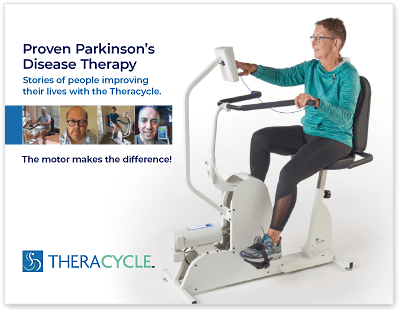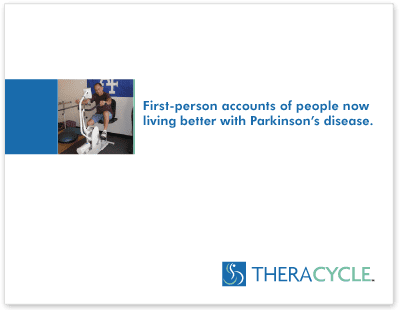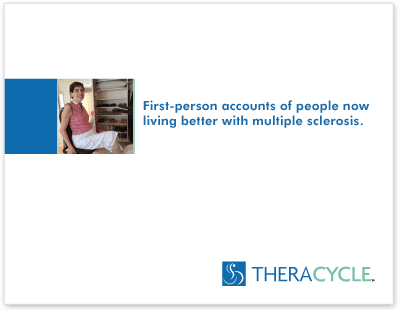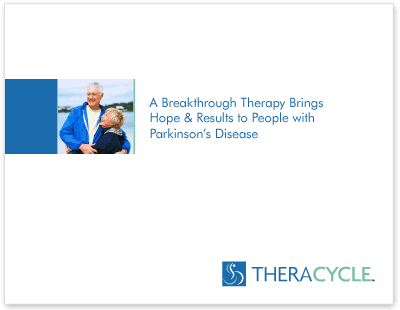- ›
- Resources
- ›
- Parkinson’s Exercises
Parkinson’s Exercises
Medically reviewed by David Dansereau, MSPT
There is no question about it, the benefits of exercise and physical activity are countless and have been known to humankind for centuries. In 1887, the New England Journal of Medicine stated:
Exercise sustains and improves bodily health by expanding the lungs, quickening the circulation, and promoting growth in muscles and bones. But we know that besides doing all these things, exercise may be made to contribute to brain growth and to the symmetrical development of the mental faculties.”
For people dealing with Parkinson’s, Parkinson’s exercises are an especially important component to a holistic approach for achieving a far better quality of life. According to the Parkinson’s Foundation, research has shown that exercises for Parkinson’s Disease can improve gait, balance, tremor, flexibility, grip strength and motor coordination. Exercise such as treadmill training and biking have all been shown to benefit, along with Tai Chi and yoga.
Exercise boosts fitness levels, builds muscles and bones, and improves motor symptoms, which can also reduce the risk of falls. Not only will Parkinson’s exercises benefit the body, but Parkinson’s Disease exercises also benefit brain functioning. According to neuroscientists, exercise stimulates the growth of new neurons which in turn improves cognitive function, including thinking and memory.
People with Parkinson’s state that exercise reduces their symptoms and can slow progression of the disease, and the sooner one starts an exercise routine, the better. Further, regular exercise has an antidepressant effect. According to Harvard Medical School, low-intensity exercise sustained over time spurs the release of proteins called neurotrophic or growth factors, which cause nerve cells to grow and make new connections. The improvement in brain function makes you feel better.
While exercise is recommended for people dealing with Parkinson’s, first consult with your doctor, neurologist and physical therapist to determine the best Parkinson’s Disease exercises for your specific Parkinson’s Disease symptoms.
Best Exercises for Parkinson’s
Aerobic Exercises
Aerobic exercises are activities that work out the cardiorespiratory system, such as your heart and lungs. For people dealing with Parkinson’s, participating in 30–40 minutes of aerobic exercises three days a week may slow their symptoms. These types of exercise include:
- Walking
- Biking
- Running
- Pool Activates
Flexibility Training Exercises
Flexibility training exercises are activities that help maintain range of motion and posture. For people dealing with Parkinson’s, participating in flexibility training exercises for two or more days per week can help improve muscle length. These types of exercise include:
- Yoga or Tai Chi
- Stretching
Strength Training Exercises
Strength training exercises are activities that involve using your body weight or additional weight to build up your strength and add muscle mass. For people dealing with Parkinson’s, participating in strength training exercises for two days a week may slow their symptoms. These types of exercise include:
- Weightlifting
- Resistance Exercises
Balance and Agility Exercises
Balance and agility exercises are activities that combine all three of the exercises listed above: aerobic, flexibility, and strength training. For those with significant balance issues, seated aerobic exercises are also a good option that can raise the heart rate. These types of exercise include:
- Golfing
- Dancing
- Gardening
- Water Aerobics
- No-contact Boxing
- Tai Chi, Yoga or Pilates
Parkinson’s Exercises at Home
Theracycle is particularly partial to cycling as a healthy, enjoyable and low-impact form of physical activity for Parkinson’s exercises at home. Cycling is easy and doesn’t require a high level of physical skill, making it accessible to people of all ages.
The benefits of cycling have been widely and scientifically documented and can improve both physical and mental health. Riding a bike improves joint mobility, builds muscles, strengthens bones and increases cardiovascular fitness. Riding a bike can also reduce anxiety, depression and stress.
Further, the positive effects of cycling can be long-lasting and help with everyday functional activities such as balance, standing, walking and climbing stairs, thereby reducing the risk of falls and fractures. Cycling is a therapeutic activity and can be done at varying degrees of intensity—at low intensity to kickstart an exercise program or at high intensity to garner a rigorous workout.
Cycling is a simple, safe and rewarding form of exercise that can be done either indoors on a stationary bike or outdoors on the road. While riding outdoors is fun and provides a scenic workout, biking outside may not be attainable for everyone. Indoor stationary cycling offers a tangible workout which can be done in the convenience of your home or gym. Go ahead, get on your bike or Theracycle, take a spin and reap the benefits of good health! Learn how an exercise program with a Theracycle therapy bike for Parkinson’s can assist you during your Parkinson’s journey, all from the comfort and safety of your own home.
Exercise and Cognitive Stimulation
Research has shown that some of the best approaches to exercise for people with Parkinson’s disease includes simultaneous mental and physical exercise. Another term for this is dual-tasking.
Dance, for example, incorporates movement and stimulation of the brain. One has to remember steps, often complex, and merge them into physical activity. Dancing improves brain function on several levels by incorporating cognitive thought processes with muscle memory.
Dance has received attention because recent studies have demonstrated dance’s ability to improve mobility and health-related quality of life in people with PD, effectively impacting motor (endurance and risk of falls) and non-motor functions (executive functions). A study from the International Journal of Gerontology, Therapeutic Dancing for Parkinson’s disease, suggests that therapeutic dancing can be beneficial for improving motor performance, mobility and balance in people with PD. Dancing can also have a positive impact on quality of life and adherence to physical activity over time. Dancing has been associated with short-term improvements in freezing of gait, walking performance and well-being in some individuals. Dance provides a rich experience involving several senses, creative expression and social interaction.
Conductorcise® Exercise for Cognitive Stimulation
Another form of movement that involves cognitive function is Conductorcise®, created by long-term conductor David Dworkin, which works out the upper body, is low impact and doesn’t require much skill, making it easy for people who are older, overweight or chair bound. The goal is for participants to feel the beat and wave their arms to the music. Conductors have to remember several hundred parts to conduct an orchestra. They’re constantly moving; they’re standing up; they’re dancing. They get a tremendous amount of physical and mental exercise simultaneously. Maestros also claim that conducting is a spiritual experience. Did you know that orchestra conductors live longer than nearly any other group of people?
But you don’t have to take a Conductorcise class to get into the swing of things. Just turn on the music, grab a baton (or stick), and start moving!
Check out these cognitive stimulation activities from NeuroUP, to enhance cognitive functions frequently affected in people with Parkinson’s disease: attention, visuospatial skills, information processing, and executive function.
Parkinson’s Exercise Programs
There are several exercise programs on the market that have been developed specifically for those with Parkinson’s. Rock Steady Boxing, a non-contact boxing-based fitness program, consists of exercises that have been adapted from boxing drills designed to improve PD symptoms.
Dance for PD® offers specialized dance classes to people with Parkinson’s in more than 100 communities around the world. Their classes allow people with Parkinson’s to experience the joys and benefits of dance while addressing symptom-specific concerns related to cognition, balance, motor skill, depression and confidence
LSVT BIG, a component of the Lee Silverman Voice Treatment program, is an exercise program for people with PD, based on the principle that the brain can learn and change. The goal of LSVT BIG is to improve people’s ability to make bigger movements which can be applied for different activities and situations, leading to faster walking with bigger steps, better balance and improved quality of life.
Exercise Routines for Parkinson’s
There is not a “one-size-fits-all” exercise program for everyone with Parkinson’s. Your doctor, neurologist and physical therapist can recommend an exercise routine that’s suited to your specific Parkinson’s symptoms, needs, goals and fitness level.
It’s never too late to begin exercises for Parkinson’s Disease. In the beginning, as you embark upon an exercise routine to combat your Parkinson’s disease symptoms, you don’t need to exercise vigorously, just regularly—daily if possible. A simple walk in the park, a gentle yoga or tai chi session, early morning stretching, an uplifting dance class, a climb up a flight of stairs, or a relaxed bike ride around the neighborhood are fun and efficient forms of Parkinson’s exercise to get the body moving.
The best way for people with Parkinson’s to experience the benefits from Parkinson’s exercise is to adopt a regular routine, be consistent and to commit to exercise long-term. People who commit to an exercise regimen for 6 months or more show significant improvements in comparison to those who commit short-term.
Once your body adjusts to a regular Parkinson’s exercise regimen, you can increase the level of intensity of exercise and incorporate more challenging and progressive activities, including a forced exercise program, an exercise/therapy where people with Parkinson’s exercise at a rate and duration greater than what they can do on their own.
As stated above, when it comes to Parkinson’s exercises, there is not a “one-size-fits-all” program. This means there are many different workouts and directions you can take, which can lead to questions. If you are asking yourself what direction might be the best for you, we recommend giving the Parkinson’s Foundation’s podcast Substantial Matters: Life & Science of Parkinson’s a listen.
Exercise is an important part of healthy living for everyone, but for people with Parkinson’s disease, it is more than healthy – exercise is medicine. Countless research studies have shown that exercises for Parkinson’s Disease benefit both the body and the brain. This episode answers a lot of frequently asked questions about how important exercises for Parkinson’s Disease are for people dealing with Parkinson’s.
Speak with your doctor or physical therapist to set exercise goals that are right for you and stick to a plan. Once you start moving, you may not want to stop!
Learn More About Using Theracycle for Parkinson’s Disease Exercise »







